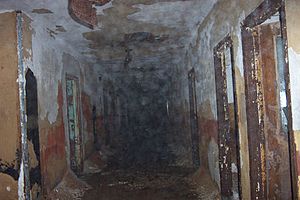Glenn Dale Hospital facts for kids
Quick facts for kids Glenn Dale Hospital |
|
|---|---|
| Geography | |
| Location | Glenn Dale, Maryland, United States |
| Organization | |
| Hospital type | Specialist |
| Services | |
| Speciality | Tuberculosis hospital and Sanatorium |
| History | |
| Closed | 1981 |
Glenn Dale Hospital was a special hospital in Glenn Dale, Maryland, in the United States. It was built to help people who had tuberculosis, a serious lung disease. This large hospital had 23 buildings spread across a huge area. It opened in 1934 and closed in 1981. It had to close because of asbestos, a material that can be harmful to health.
Even though it is now closed, for many years it was a very important place for public health near Washington, DC. The hospital grounds are regularly checked by the Maryland-National Capital Park and Planning Commission Park Police.
Contents
Exploring the Hospital Grounds
The hospital grounds are quite large and include many different buildings. These buildings were used for various purposes related to patient care and hospital operations.
Key Buildings at Glenn Dale
Some of the main buildings on the hospital grounds included:
- Children's Hospital Building
- Adult Hospital Building
- Nurses' Homes
- Doctor's Houses
- Employee Buildings
- Laundry
- Heating and Power Plant
- Warehouse and Mechanics Garage
Other parts of the hospital included art rooms, playgrounds, a theater, chapels, and morgues.
Current State of the Buildings
Today, the buildings show signs of age and neglect. You can see broken glass, peeling paint, and walls that have rusted. Many buildings also have vines growing all over them, and some roofs have fallen in.
The children's hospital building and the adult hospital building are often explored by people. This is because they are easy to reach from Glenn Dale Road, a local street that goes through the hospital area.
Tunnels and Basements
Like many old hospitals, Glenn Dale Hospital has a network of tunnels. These tunnels connect the basements of the children's and adult hospital buildings. The basements of the hospital buildings are not safe. They contain old, rusty metal, trash, and broken glass. There are also large amounts of asbestos and lead paint, which can be dangerous. Each hospital basement also had its own morgue. Today, these tunnels are often covered in graffiti and are home to rats and bats. Some parts of the tunnels can also be flooded with water.
It's important to know that a large incinerator on the hospital grounds was used to burn hospital waste, not human remains.
Future Plans for Glenn Dale Hospital
Since the hospital closed, there have been discussions about what to do with the land.
Proposed Use of the Land
In 1994, a law was passed in Maryland. It said that if the hospital grounds were sold, they should be used for a retirement community. The rest of the land would become open park space. In 1995, the Maryland-National Capital Park and Planning Commission (MNCPPC) bought the property.
In 2010, the MNCPPC looked for buyers for about 60 acres of the hospital campus. They wanted to keep the surrounding 150 acres as park land. However, the bids they received were not accepted because the buyers were not licensed to run a retirement community.
Historic Recognition
The hospital is considered an important historic site. In November 2011, Glenn Dale Hospital was officially listed on the National Register of Historic Places. This listing can help make tax credits available for its restoration. In 2014, a group called Preservation Maryland added Glenn Dale Hospital to its list of historic properties that are at risk.
"Quarantined" Article and Event
The hospital was featured in a special article called "Quarantined." This article was published in The Washington Post Magazine on December 10, 2006. It was written by Leah Y. Latimer, a former staff writer. The article shared the story of Latimer's mother, who was a patient at Glenn Dale in the 1950s. It also talked about how this experience affected their family.
On October 4, 2008, Leah Latimer gave a talk right on the grounds of Glenn Dale Hospital. This was a special event because it was the first time the public was allowed on the hospital grounds in almost 30 years. Even though it wasn't widely advertised, more than 150 people came to hear her speak.
Gallery
- Glenn Dale Tuberculosis Hospital and Sanatorium, Prince George's County, Inventory No.: PG:70-50, including undated photo, at Maryland Historical Trust website





